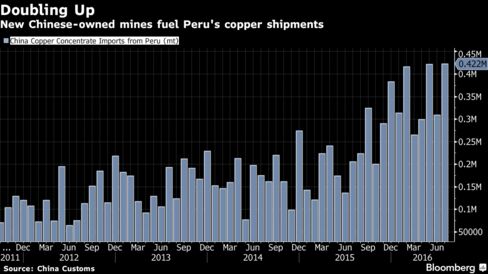
Peru’s new President Pedro Pablo Kuczynski, a veteran of Wall Street and the World Bank, will make his first visit abroad as head of state to China this week as he looks to drum up investment in mining and infrastructure. It is a sign of the times — his three predecessors had all headed to the White House on assuming office.
Kuczynski will meet Chinese President Xi Jinping on Tuesday in Beijing and Premier Li Keqiang on Wednesday, and also plans meetings with executives from the banking, mining and other industries in Beijing and Shanghai throughout the week.
China overtook the U.S to become Peru’s largest export market in 2014, purchasing $3.4 billion of mostly copper and other industrial metals in the first half of this year. Now Kuczynski, who took office July 28, is seeking to make good on a campaign pledge to lure Chinese investment to projects including a copper smelter and a coastal railway, while opening up new markets for Peruvian farm produce.
“It’s a strategic alliance of vital importance,” said Cesar Alvarez, head of research at the Centrum Catolica business school in Lima. “Peru needs infrastructure investment to reduce logistics costs, and China also has the technology Peru needs to develop industries such as smelting, agriculture and forestry.”
China Minmetals Corp. and Aluminum Corp of China Ltd. are behind the biggest copper mines to be built in Peru in the past decade. Output from those mines fueled a 43 percent increase in Peru’s copper sales to China in the first six months of this year, as surging volumes offset the slide in prices.

Peru supplies 25 percent of China’s copper imports, while neighboring Chile accounts for 28 percent.
It isn’t just copper. Non-commodity exports are rising thanks partly to a free-trade agreement the two countries signed in 2009. Farm exports have become a focus for the government’s efforts to diversify the economy away from metals after copper’s value fell by half in the past five years.
Peru’s sales of fresh produce increased 3.4 percent to $4.3 billion last year. Shipments to China totaled $104 million in 2015, led by sales of table grapes, which was 5.8 percent less than 2014 and well below the $1.4 billion sold to the U.S.
Kuczynski will likely ask China to ease restrictions on Peruvian products such as avocado and blueberries, said Jessica Luna, general manager of exporter group ComexPeru. “There’s a lot of room for non-commodity exports to keep growing,” Luna said.
Kuczynski has said he plans to seek associate membership of the Beijing-based Asian Infrastructure Investment Bank during his visit to obtain financing for projects.
More than 170 Chinese companies have offices in Peru and 300 Chinese executives will attend a Asia-Pacific Economic Cooperation business summit being organized by ComexPeru in Lima in November, Luna said.



Expositores: Oscar Vidarte (PUCP) Fernando González Vigil (Universidad del Pacífico) Inscripciones aquí. Leer más
Una retrospectiva para entender los próximos cuatro años. Leer más
En la conferencia se hará una presentación de los temas más relevantes del proceso de negociación se llevó a cabo desde el 2012, así como del acuerdo de paz firmado entre el Gobierno colombiano y la guerrilla de las FARC a finales del 2016. Se analizarán los desafíos y las... Leer más
El Observatorio de las Relaciones Peruano-Norteamericanas (ORPN) de la Universidad del Pacífico es un programa encargado de analizar y difundir información relevante sobre la situación política, económica y social de Estados Unidos y analizar, desde una perspectiva multidisciplinaria, su efecto en las relaciones bilaterales con el Perú.
© 2025 Universidad del Pacífico - Departamento Académico de Humanidades. Todos los derechos reservados.

